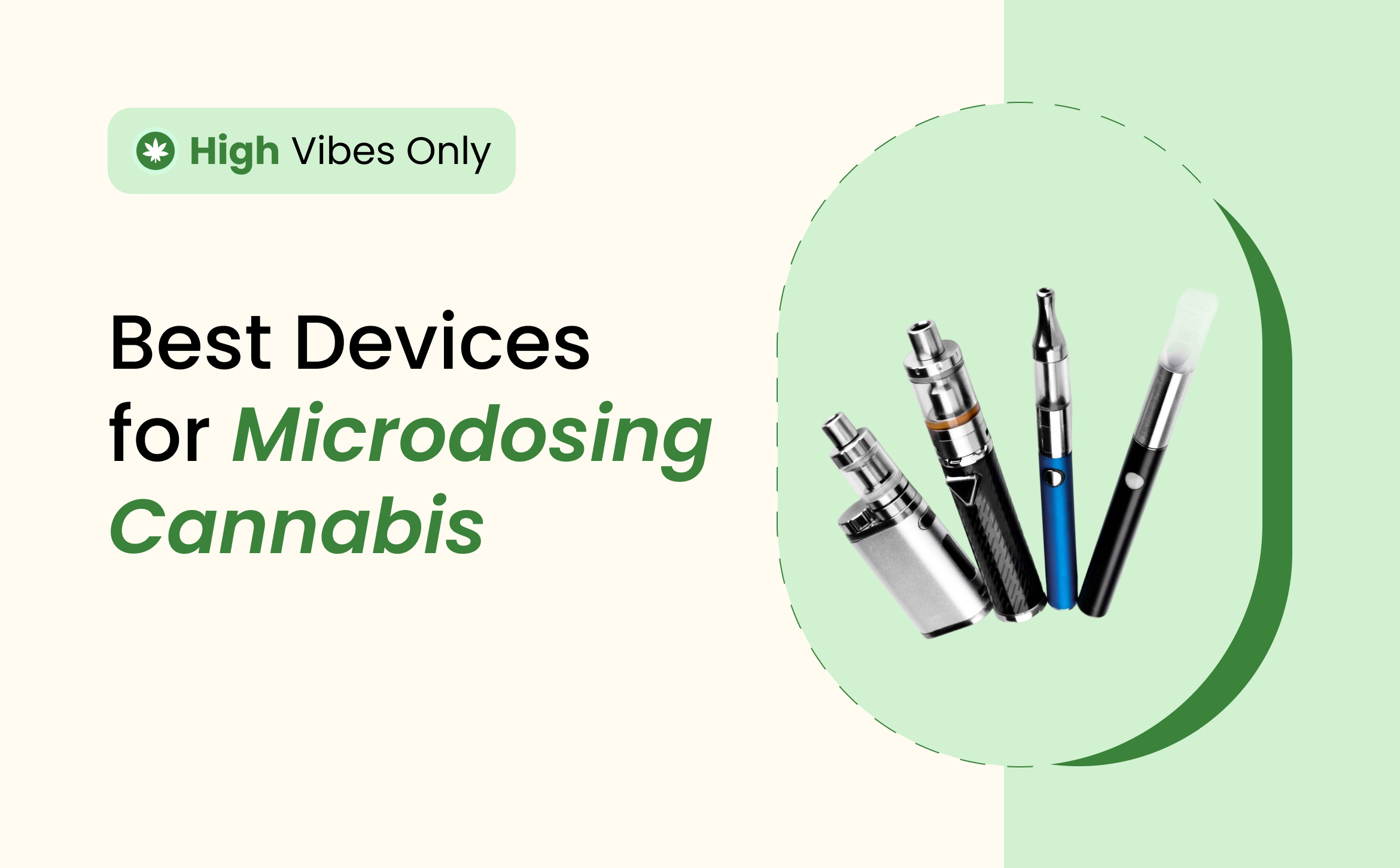Cannabis isn’t just about getting high anymore. For a growing number of people, it’s the tool they reach for to stay grounded, clear-headed, and just a little more in control. That’s where microdosing comes in.
Microdosing cannabis means taking very small amounts—just enough to get subtle benefits like reduced anxiety, better sleep, or a boost in creativity. Whether you’re a beginner or someone who wants more control over your experience, microdosing can be the perfect solution.
But here’s the thing: the way you consume cannabis plays a big role in how it works. The right device can make your microdosing experience smoother, more accurate, and more enjoyable.
In this guide, we’ll explore the best devices for microdosing cannabis and how to choose the one that fits your lifestyle.
Table of Contents
ToggleWhat Is Microdosing Cannabis?
Think of microdosing cannabis like adding just a splash of spice to your food—not enough to overpower the dish, but just enough to change the way it feels.
Microdosing means taking tiny amounts of cannabis, usually 1 to 2.5 mg of THC, to feel just the right amount of effect—without getting high, spaced out, or stuck to your couch.
The goal? To tap into the good stuff—like better mood, less pain, deeper focus, or calmer nerves—without losing control or zoning out. It’s subtle, smooth, and often so gentle you won’t even realize it’s working until you notice you just feel better.
Whether you’re new to cannabis or just tired of overdoing it, microdosing is a smarter, softer way to get the benefits without the baggage.
Why do people microdose cannabis?
Let’s be honest—getting too high isn’t always the vibe. Microdosing gives you just enough to feel better, clearer, and more in control. Here’s why more and more people are leaning into it:
- To manage stress or anxiety during the day
- For help with sleep or relaxation at night
- To improve focus or boost creativity
- To ease chronic pain or inflammation
- To enjoy cannabis without overwhelming effects
Microdosing is popular among professionals, parents, seniors, and health-conscious users who want the benefits of cannabis without losing clarity or control.
Why the Right Device Matters
You might think any cannabis product can be microdosed, but that’s not true. Many traditional forms, like joints or strong edibles, make it hard to control how much THC you’re getting. That’s why choosing the right device is so important.
A good microdosing device should:
- Offer consistent, low-dose delivery
- Be easy to measure and use
- Act fast or slow—depending on your needs
- Be discreet and portable for daily use
- Avoid combustion (smoking) for better health
So, if you want to microdose with confidence—not guesswork, choosing the right tool is key. Let’s walk through the most popular device types and how they help you stay in control, one small dose at a time.
Top Devices for Microdosing Cannabis
1. Vape Pens (Low-Temperature Vaporizers)
Vape pens are one of the most popular tools for microdosing cannabis—and for good reason. These sleek devices heat cannabis oil or dry flower at lower temperatures to produce vapor rather than smoke, offering a smoother experience that’s easier on the lungs. Unlike edibles, the effects kick in within minutes, giving you faster feedback.
Because you can take tiny puffs, vape pens make it easy to find your sweet spot. Some models even feature dose control settings or come pre-filled with low-dose cartridges, making them especially beginner-friendly.
Popular Picks:
- PAX Era – App-controlled with precise temperature settings
- Dynavap M – Battery-free and perfect for dry herb micro-hits
Pros:
- Fast onset of effects
- Easy to carry and discreet
- Smooth, flavorful vapor
Cons:
- Requires charging or manual heating
- Hard to gauge dosage without experience
2. Tinctures and Sublingual Sprays
Tinctures are liquid cannabis extracts taken under the tongue using a dropper or spray. This sublingual method allows the cannabinoids to absorb into your bloodstream fairly quickly—typically within 15 to 30 minutes.
What makes tinctures ideal for microdosing is their precision. You can measure your dose down to the milligram, making it easier to start small and increase gradually if needed. They’re also discreet, portable, and often flavor-neutral or herbal in taste.
Recommended Options:
- Papa & Barkley Releaf Tincture
- Mary’s Medicinals Sublingual Spray
Pros:
- Ultra-precise dosing
- Easy for beginners
- Discreet and travel-friendly
Cons:
- May have a strong or earthy taste
- Slightly slower onset than vaping
3. Edibles with Microdose Formulation
Edibles like gummies, chocolates, or mints offer a delicious and approachable way to microdose—especially for those who don’t want to inhale anything. These products are digested, meaning they take longer to kick in (usually 30 to 90 minutes) but deliver longer-lasting effects.
Many brands now offer edibles designed for microdosing, with just 1–2.5mg THC per serving. This makes it easier to enjoy the subtle benefits without getting too high, especially for evening wind-downs or restful sleep.
Top Picks:
- Kiva Petra Mints – 2.5mg THC per mint
- Camino Gummies – Available in 2–5mg doses
Pros:
- Tasty and enjoyable
- Effects last 4–6 hours
- Great for relaxation or nighttime use
Cons:
- Delayed onset
- Easy to overdo if you’re impatient
4. THC Inhalers
THC inhalers are medical-grade devices that deliver cannabis in a precisely measured aerosol spray, similar to an asthma inhaler. Unlike smoking or vaping, there’s no combustion or vapor—just clean, metered dosing straight to your lungs.
These inhalers are ideal for people who want fast, reliable effects with zero guesswork. Though slightly more niche and expensive, they’re one of the most controlled ways to microdose.
Leading Devices:
- Syqe Inhaler
- Aerosphere THC Inhaler
Pros:
- Precise, medical-grade dosing
- Rapid onset
- No smoke or odor
Cons:
- Higher cost
- Not widely available in all regions
5. Dry Herb Vaporizers with Dose Control
If you prefer using whole cannabis flower, dry herb vaporizers are an excellent option. These devices heat the flower just enough to release cannabinoids and terpenes without burning it, preserving flavor and avoiding harsh smoke.
What sets them apart for microdosing is the ability to load a very small amount—just a pinch—into the chamber. Some devices also have “microdose mode” or smart temperature settings to help regulate intake.
Recommended Devices:
- DaVinci Miqro – Small, stylish, and designed for microdosing
- Arizer Solo II – Known for consistency and full-spectrum vapor
Pros:
- Full terpene flavor and effect
- Great for flower enthusiasts
- Adjustable dosage control
Cons:
- Requires a bit more setup
- Not as discreet in smell or appearance
How to Choose the Best Microdosing Device for You
Not all devices are right for everyone. Your best choice depends on your goals, lifestyle, and comfort level with cannabis.
Ask yourself:
- Do I want fast effects (vaping, inhaler) or longer-lasting relief (edibles)?
- Do I prefer discreet use at work or in public?
- Do I want full control over dosage?
- Am I more comfortable with oils, flower, or edibles?
If you’re new, start with tinctures or microdose edibles—they’re the easiest to measure. If you’re experienced or want quick relief, try vape pens or dry herb vaporizers with precise temp control.
Pro Tips for Effective Microdosing
Microdosing can be a game-changer when done right—but it requires intention, awareness, and patience. Whether you’re exploring cannabis for focus, relaxation, or creativity, these practical tips will help you get the most out of each microdose while avoiding common pitfalls.
- Start low, go slow:
Begin with a small dose (1–2mg THC or CBD) and wait at least 2 hours to assess its effects before considering another dose—especially if you’re new to microdosing. - Use a journal:
Keep a simple log of what you took, when you took it, and how you felt afterward. This helps you identify your ideal dose and avoid overdoing it. - Pair with intention:
Microdose with a clear goal in mind—whether it’s staying focused during work, easing into meditation, or relaxing before sleep. Intentional use often leads to better results. - Be patient:
Especially with edibles, effects can take up to 90 minutes to kick in. Avoid redosing too soon to prevent an unintentional high. - Know your setting:
For your first few times, choose calm, familiar environments. Avoid microdosing in high-stress or unfamiliar situations until you understand how your body reacts.
Final Thoughts
Microdosing cannabis is all about intention, control, and balance. With the right device, you can enjoy the benefits of cannabis without the overwhelming effects, making it a smart, sustainable option for daily use.
Whether you’re easing into cannabis for the first time or looking for a more mindful way to consume, choosing the right microdosing device makes all the difference. Start small, stay consistent, and enjoy the calm that comes with doing it right.
FAQs
Yes, for most people it is. But it’s always best to consult a doctor, especially if you’re on other medications.
Absolutely. Many users prefer balanced formulas (like 1:1 THC: CBD) to reduce psychoactive effects and increase wellness benefits.
Yes. Even small amounts of THC can be detected in a drug test, depending on how often you use it.
It depends on the method. Vape effects last 1–2 hours; edibles can last 4–6 hours.
Yes, but you’ll need to portion them carefully. Devices designed for microdosing make it easier and safer.


